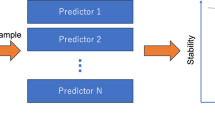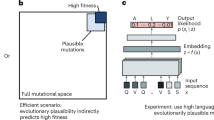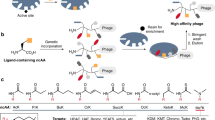Abstract
Enzymes have evolved their ability to use binding energies for catalysis by increasing the affinity for the transition state of a reaction and decreasing the affinity for the ground state. To evolve abzymes toward higher catalytic activity, we have reconstructed an enzyme-evolutionary process in vitro. Thus, a phage-displayed combinatorial library from a hydrolytic abzyme, 6D9, generated by the conventional in vivo method with immunization of the transition-state analog (TSA), was screened against a newly devised TSA to optimize the differential affinity for the transition state relative to the ground state. The library format successfully afforded evolved variants with 6- to 20-fold increases in activity (kcat) as compared with 6D9. Structural analysis revealed an advantage of the in vitro evolution over the in vivo evolution: an induced catalytic residue in the evolved abzyme arises from double mutations in one codon, which rarely occur in somatic hypermutation in the immune response.
This is a preview of subscription content, access via your institution
Access options
Subscribe to this journal
Receive 12 print issues and online access
$209.00 per year
only $17.42 per issue
Buy this article
- Purchase on Springer Link
- Instant access to full article PDF
Prices may be subject to local taxes which are calculated during checkout




Similar content being viewed by others
References
Tramontano, A., Janda, K.D. & Lerner, R.A. Catalytic antibodies. Science 234, 1566–1570 (1986).
Pollack, S.J., Jacobs, J.W. & Schultz, P.G. Selective chemical catalysis by an antibody. Science 234, 1570–1573 (1986).
Lerner, R.A., Benkovic, S.J. & Schultz, P.G. At the crossroads of chemistry and immunology: catalytic antibodies. Science 252, 659–667 (1991).
Schultz, P.G. & Lerner, R.A. From molecular diversity to catalysis: lessons from the immune system. Science 269, 1835–1842 (1995).
Wirsching, P., Ashley, J.A., Lo, C-H.L., Janda, K.D. & Lerner, R.A. Reactive immunization. Science 270, 1775–1782 (1995).
Wentworth, P. Jr. et al. A bait and switch hapten strategy generates catalytic antibodies for phosphodiester hydrolysis. Proc. Natl. Acad. Sci. USA 95, 5971–5975 (1998).
Barbas, C.F., Kang, A.S., Lerner, R.A. & Benkovic, S.J. Assembly of combinatorial antibody libraries on phage surface: the gene III site. Proc. Natl. Acad. Sci. USA 88, 7978–7982 (1991).
Janda, K.D. et al. Chemical selection for catalysis in combinatorial antibody libraries. Science 275, 945–948 (1997).
Arkin, M.R. & Wells, J.A. Probing the importance of second sphere residues in an esterolytic antibody by phage display. J. Mol. Biol. 284, 1083–1094 (1998).
Gao, G. et al. Direct selection for catalysis from combinatorial antibody libraries using a boronic acid probe: primary amide bond hydrolysis. J. Am. Chem. Soc. 120, 2211–2217 (1998).
Fujii, I. Fukuyama, S., Iwabuchi, Y. & Tanimura, R. Evolving catalytic antibodies in a phage-displayed combinatorial library. Nat. Biotechnol. 16, 463–467 (1998).
Tanaka, F., Lerner, R.A. & Barbas, C.F. Reconstructing aldolase antibodies to alter their substrate specificity and turnover. J. Am. Chem. Soc. 122, 4835–4836 (2000).
Ulrich, H.D. et al. The interplay between binding energy and catalysis in the evolution of a catalytic antibody. Nature 389, 271–275 (1997).
Tonegawa, S. Somatic generation of antibody diversity. Nature 302, 575–581 (1983).
Neuberger, M. & Milstein, C. Somatic hypermutation. Curr. Opin. Immunol. 7, 248–254 (1995).
Pauling, L. Chemical achievement and hope for the future. Am. Sci. 36, 51–58 (1948).
Lienhard, G.E. Enzymatic catalysis and transition-state theory. Science 180, 149–154 (1973).
Fersht, A. Enzyme structure and mechanism, Edn. 2 (W.H. Freeman and Co., New York, NY; 1985).
Miyashita, H., Karaki, Y., Kikuchi, M. & Fujii, I. Prodrug activation via catalytic antibodies. Proc. Natl. Acad. Sci. USA 90, 5337–5340 (1993).
Miyashita. H. et al. A common ancestry for multiple catalytic antibodies generated against a single transition-state analog. Proc. Natl. Acad. Sci. USA 91, 6045–6049 (1994).
Fujii, I., Tanaka, F., Miyashita, H., Tanimura, R. & Kinoshita, K. Correlation between antigen-combining-site structures and functions within a panel of catalytic antibodies generated against a single transition state analog. J. Am. Chem. Soc. 117, 6199–6209 (1995).
Kabat, E.A., Wu, T.T., Perry, H.M., Gottesman, K.S. & Foeller, C. Sequences of proteins of immunological interest, Edn. 5. (US Department of Health and Human Services. National Institutes of Health, Bethesda, MD; 1991).
Miyashita, H. et al. Site-directed mutagenesis of active site contact residues in a hydrolytic abzyme: evidence for an essential histidine involved in transition state stabilization. J. Mol. Biol. 267, 1247–1257 (1997).
Kristensen, O., Vassylyev, D.G., Tanaka, F., Morikawa, K. & Fujii, I. A structural basis for transition-state stabilization in antibody-catalyzed hydrolysis: crystal structures of an abzyme at 1.8 Å resolution. J. Mol. Biol. 281, 501–511 (1998).
Cagnon, C., Valverde, V. & Masson, J.-M. A new family of sugar-inducible expression vectors for Escherichia coli. Protein Eng. 4, 843–847 (1991).
Fersht, A.R. et al. Hydrogen bonding and biological specificity analysed by protein engineering. Nature 314, 235–238 (1985).
Corbet, S., Milili, M., Fougereau, M. & Schiff, C. Two Vκ germ-line genes related to the GAT idiotypic network (Ab1 and Ab3/Ab1') account for the major subfamilies of the mouse Vκ-1 variability subgroup. J. Immunol. 138, 932–939 (1987).
Huse, W.D. et al. Generation of a large combinatorial library of the immunoglobulin repertoire in phage lambda. Science 246, 1275–1281 (1989).
Takahashi, N. et al. Efficient screening for catalytic antibodies using a short transition-state analog and detailed characterization of selected antibodies. Eur. J. Biochem. 261, 108–114 (1999).
Angeles, T.S. et al. Isoabzymes: structurally and mechanistically similar catalytic antibodies from the same immunization. Biochemistry 32, 12128–12135 (1993).
Acknowledgements
We thank Ms. K. Inoue for her technical assistance and Dr. K. Akiyama, Dr. Y. Aoki, and Dr. K. Shimazaki for their helpful suggestions. This research was supported by the New Energy and Industrial Technology Development Organization as an R&D project of the Industrial Science and Technology Frontier Program.
Author information
Authors and Affiliations
Corresponding author
Rights and permissions
About this article
Cite this article
Takahashi, N., Kakinuma, H., Liu, L. et al. In vitro abzyme evolution to optimize antibody recognition for catalysis. Nat Biotechnol 19, 563–567 (2001). https://doi.org/10.1038/89320
Received:
Accepted:
Issue Date:
DOI: https://doi.org/10.1038/89320
This article is cited by
-
Baculovirus display of functional antibody Fab fragments
Cytotechnology (2015)
-
Catalytic antibodies and their applications in biotechnology: state of the art
Biotechnology Letters (2014)
-
Design of a serine protease-like catalytic triad on an antibody light chain displayed on the yeast cell surface
Applied Microbiology and Biotechnology (2007)
-
Turnover-based in vitro selection and evolution of biocatalysts from a fully synthetic antibody library
Nature Biotechnology (2003)



